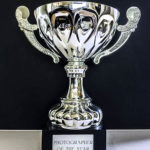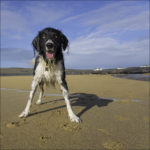Hours: 0 to 0

Photographer of the Year Cup
(Advanced Category)
Competition Strategy & Tactics
Last season I won the Stoke Poges Photographic Club’s Photographer of the Year award, calculated by taking each person’s top 12 scores from the season’s 8 competitions (4 prints and 4 projected digital images). Scoring out of 20, I had 9 20s and sufficient 19s to give my top-12 a total of 237.
We are a fairly small club of about 50 members, divided pretty equally between “Intermediate” and “Advanced” members.
I spent my first year with the club just watching the competitions and how they were judged and it became apparent that people consistently lost points for easily rectifiable reasons.
At our club, everybody, unless they have an RPS distinction, starts in Intermediate and progress only once they finish in the top two places of this section. I’m a competitive bugger and in my second year with the club I set out to win. I applied what I had learnt and am now in the advanced group.
Is this a cheat-sheet, checklist? (Yes)
Tip No. 1: The mathematics of the scoring means, “you have to be in it to win it.” Enter every competition with:
- The maximum number of images
- Where possible split these equally between the Set-Subject and Open categories
- Submit high risk images, “more of the same” shots that might score 16, 17 or 18 are no good. The only thing that matters for winning is the number of 20s (and 19s). The 13s, 14s and 15s are forgotten.
If you have any ideas or thoughts, please post comments below.
To see more posts on other photographic topics, or to follow my learning progress, please like or follow me on the social media channel of your choice to the right.
Shooting and Selecting Images for Competitions
A wise man from the Royal Photographic Society once defined photography as consisting of the following 5 steps:
- Seeing
- Thinking
- Taking
- Making
- Presenting
When shooting specifically for a competition, the above steps are more targeted. It is a good idea to Google images on the subject in advance and gain “inspiration”, i.e., potential compositions or images to copy. I find shooting “on purpose” is more fun and more rewarding. I make a plan, and find that this helps even though I have to adapt and change often quite considerably.
First Set of Tips: for Set-Subjects
Sometimes one sees judges really struggle. :
- Ensure that the image fits the set-subject:
- Would the image make a suitable cover for a book on the subject in question?
- In my experience subtle references, however clever, don’t cut it
- If you were asked to describe the image, would the set-subject title be some of the first words you would use?
- Make the main point of the image really obviously the first place where the eye is drawn to, i.e., the dominant feature of the image
(I post tips like these as I discover them on my facebook page and through my twitter account. Please Like and follow me to access.)
Present a Clean Image
In my opinion, a “clean image” is one that:
- Is free from distracting elements
- If there are bright spots, big blocks of bold colour or other areas of high contrast that are not the main subject of the image, toning them down using Lightroom, Photoshop or whatever editing software
- Clone out any elements that are not intrinsic to the image, e.g., litter in a landscape shot, or people in an architectural image.
(This is a pain to do well at this stage, and I am always reminded to spend a little longer tidying the scene or waiting for people to get out of the way at the taking stage!)
- Finishes neatly at the edges and particularly the corners.
Run your eye around the edges and corners:- Are these clean or scruffy?
- Leading lines should ideally emerge from a corner.
(Traditionally bottom left, I think).
Tips for Projected Images
- Get the size right. Make it as big as possible, but no bigger. Current size limitation for CACC clubs is 1600 wide by 1200 high
- Your image will look different projected than it does on your screen, just be aware that light areas may blow out and/or dark areas loose detail
- Always put a thin border or key-line around your image. This makes it look smart and shows where the image finishes. I have not found a way to do this in Lightroom. So I use Photoshop to give a 2 pixel each side canvas extension, which with a solid white layer under the image yields a 2 pixel keyline. I then add a 1 pixel Black Outside Stroke to the image, which reduces the keyline to 1 pixel all round and produces a clean edge that works for both dark and light areas finishing against any background.
Tips for Printed Images
Prints should be mounted using standard mount board which should be no larger than 50x40cm, either portrait or landscape, and the size of the image within the mount doesn’t matter.
Like many things in photography, good (expensive) kit produces the best images and printing is sadly no exception to this. Although an entry A3 photo printer can be purchased from Amazon for less than £150 and quite a good one judging from the reviews, this is only the start; add paper, inks, mountboard, mountboard cutter, replacement blades, first-aid kit… and the prices mount.
However, there are some ways round this for the financially constrained or “tight-wads” like me. Most notably http://costco.photokio.sk/about/Print_Prices are apparently excellent, if you live near a warehouse and pre-cut mounts complete the package.
I use GS Photos in Gerrards Cross (http://www.gsphotos.co.uk) who provide a good quality and intelligent service for a price where, if I’m making 16 competition prints per year, it’s just not worth buying the kit and trying to do it myself.
Other tips:
- Big is best: go for the maximum size within that allowed
- Remember: the mount will overlap the image by about 1mm or so on all sides. So allow for this when framing and cropping the image to be printed.
Don’t Take it too Seriously – Judges aren’t Perfect

The main purpose of entering a competition is to gain the feedback that helps you improve your photography. So, a judge’s opinion is just that: their opinion. This is exemplified by the photo to the right of my willing and enthusiastic photographic assistant. Although you can’t see it on the screen, trust me, the detail on the A3 print is terrific.
It scored 18 in Open competition and was criticised for one of the buildings on the horizon touching the edge of the frame – what! Judge obviously didn’t like dogs.
Somewhat aggrieved, I re-entered it in the Open Print Finals, where a different judge, who obviously did like dogs, awarded it first place.
A more obvious criticism, and one that was not missed by many club members watching the finals, is that it looks as though he only has 3 legs. However, this was not mentioned by either judge.
This blog was written whilst listening to: “The Classical Album” by Vanessa Mae, then “China Girl”.
If you have any ideas or thoughts, please post comments below.
To see more posts on other photographic topics, or to follow my learning progress, please like or follow me on the social media channel of your choice to the right.